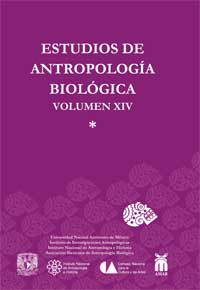Análisis del adn mitocondrial de tres series antiguas mexicanas
DOI:
https://doi.org/10.22201/iia.14055066p.2009.27243Keywords:
Mesoamerica, ancient dna, mitochondrial dnaAbstract
Mitochondrial dnA from human skeletal remains from the Mexican Plateau (the Mexican “Altiplano”) were analyzed, in order to gain insights, with the information that the maternal lineages can provide us, into dynamics of the ancient Mexican populations. mtDNA markers have been studied both by specific restriction en-zyme analysis in the coding region and by sequencing of the HVI segment. Full correspondence among mitochondrial markers was found. Eighty seven out of the 102 individuals studied were classified into one of the four major founding mtDNA haplogroups described for Native Americans while three of them didn’t segregate for any of these haplogroups. For these samples, the current data indicate an African lineage, either from L1, L2 or L3 haplogroups. The result showed that there is a genetic continuity among the three ancient series. Nevertheless, mtDNA atypical distribution in the series of Los Olmos allows us to hypothesize that this population could suffer a strong declivity due to colonization processes. The maternal Euro-pean contribution to the samples analyzed was virtually absent. However, is worth to note the finding of three individuals with African mitochondrial inheritage in the series from Hospital San Juan de Dios.
Downloads
Downloads
How to Cite
Issue
Section
License

http://creativecommons.org/licenses/by-nc-nd/4.0/


